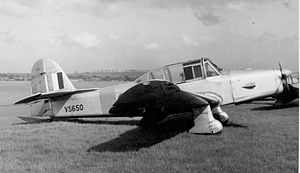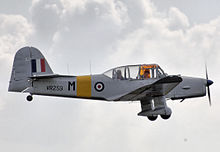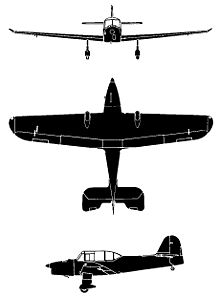Percival Prentice Video - Picture

|
|
Percival Prentice

Aircraft Picture - A Percival P.40 Prentice T.1 of No. 16 Reserve Flying School based at Derby (Burnaston) Airport in service in May 1953
Role: Military trainer aircraft
Manufacturer: Percival
First flight: 31 March 1946
Introduction: November 1947
Retired: 1953
Primary users: Royal Air Force
private pilot owners after disposal by the RAF
Produced: 1947-1949
Number built: >370
The Percival Prentice was a basic trainer of the Royal Air Force in the early post-war period. It was a low-wing monoplane with a fixed tailwheel undercarriage. Front seating was in a side-by-side configuration with a rear seat provided.
Design and development
Designed to meet Air Ministry Specification T.23/43, the Prentice was the first all-metal aircraft to be produced by Percival. The prototype Prentice TV163 first flew from Percival's factory at Luton Airport, Bedfordshire on 31 March 1946. Early trials revealed inadequate rudder control, resulting in a revised rudder and a large cut-out in the elevators. The aircraft were later modified with turned-up wingtips. Over 370 were delivered to the RAF between 1947 and 1949.
An unusual design feature was the provision for three seats. While the instructor and pupil were equipped with dual controls in a side-by-side arrangement in the front, and a second pupil sat in the rear seat without controls to receive "air experience". Both pupils could communicate with the instructor. Night flying training was to be carried out in daylight by means of amber screens incorporated into the canopy and the use of special goggles. The amber screens were folded back when not in use.
Several hundred Prentices were ordered for RAF use. Since the Percival factory was concentrating on production of the Percival Proctor and the Merganser light transport aircraft, production was sub-contracted to the Blackburn Aircraft works at Brough.
Operational service
After these modifications, the Prentice was passed into RAF service, initially with the regular Flying Training Schools (FTS) where they replaced the remaining de Havilland Tiger Moths. Later deliveries went to the Reserve Flying Schools (RFS). The type served successfully in the pilot training role until late 1953, when they were replaced by the Percival Provost. Two Air Signals Schools also operated the type to train air signallers, until the last were withdrawn from No.1 ASS at RAF Swanton Morley, Norfolk, in mid 1956.
Civilian operations

Airplane Picture - A preserved Percival Prentice giving a pleasure flight in 2007
252 redundant RAF Prentices were later bought in 1956 by Aviation Traders Ltd, a company owned by Freddie Laker. Most were eventually scrapped, but 28 were converted for civil use with two seats and two jumpseats behind the two pilots' seats, separated by a structure which housed the original 4-channel radio. This conversion had quite poor performance with 4 passengers. One aircraft was converted to a seven-seat layout for pleasure flights. One (G-AOPL) was acquired from Shackleton Aviation at Sywell by a Captain in the Trucial Oman Scouts and flown to Sharjah in 1967; later being flown on to South Africa where it remained until it ceased flying.
The aircraft had a poor performance with any load at high temperatures, and, initially, had poor spin recovery.
Sixty-six aircraft were built under licence by Hindustan Aircraft for the Indian Air Force.
Operators
Argentina
Argentine Air Force
Canada
Royal Canadian Air Force - One aircraft was evaluated and tested by the RCAF in 1948.
India
Indian Air Force
Lebanon
Lebanese Air Force
United Kingdom
Royal Air Force
Central Flying School
No.1 FTS
No.2 FTS
No.3 FTS
No.6 FTS
No.7 FTS
No.22 FTS
No.16 RFS
No.22 RFS
No.23 RFS
No.24 RFS
No.25 RFS
Survivors
G-AOLK airworthy in 2009 with private owner at Southend Airport; G-AOKL currently at Shuttleworth Collection Old Warden, who purchased it damaged, now undergoing restoration but temporarily on hold; G-APJB airworthy with Air Atlantique at Coventry Airport with air transport certificate; Prentice T.1 VS623, is displayed in the Midland Air Museum, Coventry, England. Two other Prentice survives not in flying condition in Argentina: One at the Museo Nacional de Aeronx¡utica and the other one in Escuela de Educacix³n Técnica Aeronx¡utica Jorge Newbery. Prentice VR249 (G-APIY) is displayed at Newark Air Museum, England and is a National Benchmark airframe on the National Aviation Heritage Register. Prentice N1041P ex RAF under restoration at Camarillo air museum California, USA.
Specifications (T.1)

Airplane Picture - Percival Prentice T.1
Data from
General characteristics
Crew: 2/3
Length: 31 ft 3 in (9.52 m)
Wingspan: 46 ft 0 in (14.0 m)
Height: 12 ft 10 in (3.91 m)
Wing area: 305 ft² (28.4 m²)
Empty weight: 3,232 lb (1,466 kg)
Loaded weight: 4,200 lb (1,905 kg)
Powerplant: 1 x— de Havilland Gipsy Queen 32 6-cylinder, air-cooled inline engine, 251 hp (187 kW)
Performance
Maximum speed: 124 knots (143 mph, 230 km/h) at 5,000 ft (1,500 m)
Cruise speed: 118 knots (136 mph)
Range: 344 nm (396 mi, 637 km)
Service ceiling: 18,000 ft (m)
Comparable aircraft
de Havilland Chipmunk
LWD Junak
Yakovlev Yak-18
Zlin Trener
Bibliography
Ellison, Norman H. Percivals Aircraft (The Archive Photographs Series). Chalford, Stroud, UK: Chalford Publishing Company, 1997. ISBN 0-7524-0774-0.
Halley, J.J. Royal Air Force Aircraft SA100-VZ999. Tunbridge Wells, Kent, UK: Air-Britain (Historians) Ltd. 1985. ISBN 0-85130-136-3.
Jackson, A.J. British Civil Aircraft since 1919, Volume 3. London: Putnam, 1988. ISBN 0-85177-818-6.
Silvester, John. "Percival Aircraft 1933-1954 (Parts 1-4)." Aeroplane Monthly, Vol. 11, No. 1-4, January-April 1983.
Sturtivant, Ray. Royal Air Force Flying Training and Support Units. Tunbridge Wells, Kent, UK: Air-Britain (Historians) Ltd, 1997. ISBN 0-85130-252-1.
Thetford, Owen. Aircraft of the Royal Air Force. London: Putnam & Company Ltd., 1976. ISBN 0-370-10056-5.
Percival Prentice Pictures
More airplane video.
Source: WikiPedia